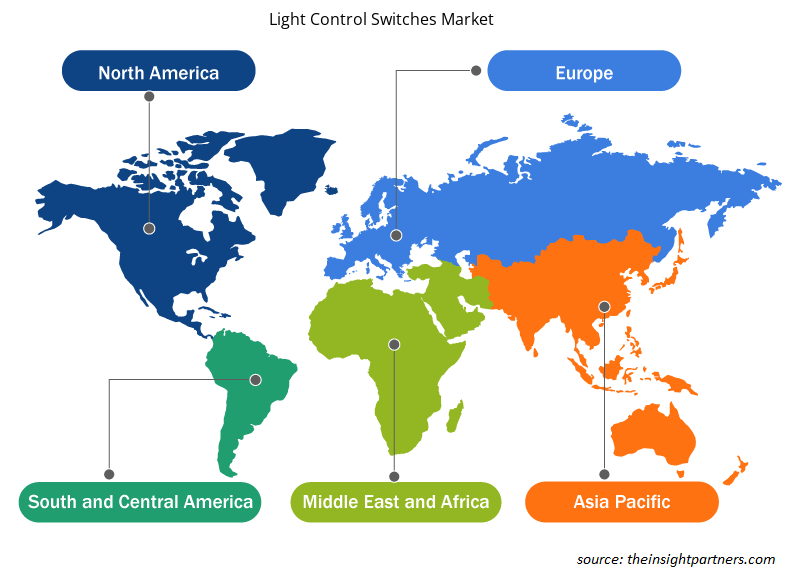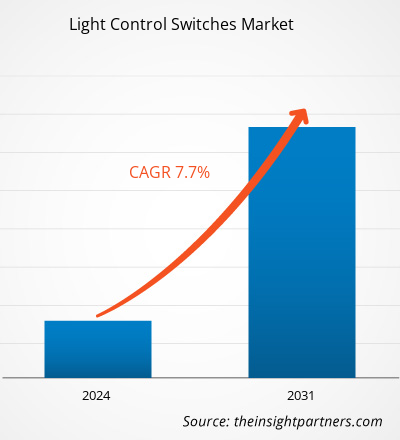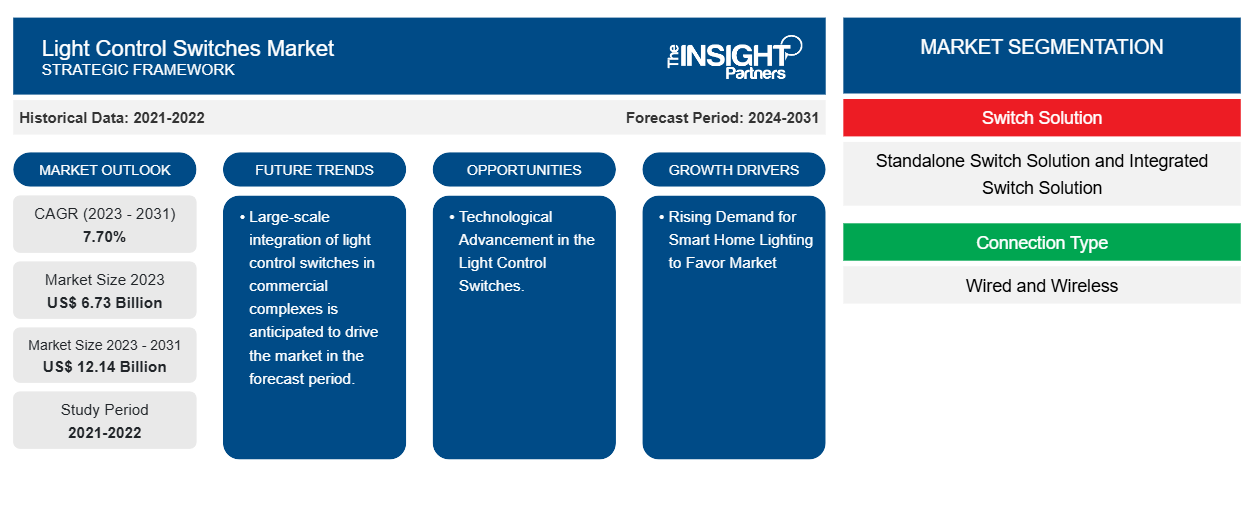Le marché des interrupteurs de commande d'éclairage devrait atteindre 12,14 milliards USD d'ici 2031, contre 6,73 milliards USD en 2023. Le marché devrait enregistrer un TCAC de 7,70 % au cours de la période 2023-2031. La demande croissante d'éclairage domestique intelligent et la construction croissante de complexes commerciaux seront probablement les principaux moteurs et tendances du marché.
Analyse du marché des interrupteurs de contrôle d'éclairage
Le marché des interrupteurs de commande d'éclairage connaît une croissance significative à l'échelle mondiale. Cette croissance est attribuée à la demande croissante d'éclairage domestique intelligent et à la construction croissante de complexes commerciaux . De plus, l'intégration à grande échelle des interrupteurs de commande d'éclairage dans les complexes commerciaux, la réglementation et les incitations gouvernementales croissantes et l'intégration de la maison intelligente devraient stimuler le marché des interrupteurs de commande d'éclairage dans les années à venir.
Aperçu du marché des interrupteurs de contrôle d'éclairage
Un interrupteur de commande d'éclairage est un interrupteur qui est généralement utilisé pour faire fonctionner des équipements connectés en permanence, des lampes électriques ou des prises électriques. Les lampes portables, y compris les lampes de table, peuvent avoir un interrupteur d'éclairage monté sur la douille, la base ou en ligne avec le cordon. Il existe plusieurs types d'interrupteurs de commande d'éclairage, notamment les interrupteurs unipolaires, les interrupteurs bipolaires, les variateurs d'intensité, les interrupteurs à bascule, les interrupteurs combinés, les interrupteurs doubles, les interrupteurs triples et autres.
Personnalisez ce rapport en fonction de vos besoins
Vous bénéficierez d'une personnalisation gratuite de n'importe quel rapport, y compris de certaines parties de ce rapport, d'une analyse au niveau des pays, d'un pack de données Excel, ainsi que de superbes offres et réductions pour les start-ups et les universités.
-
Obtenez les principales tendances clés du marché de ce rapport.Cet échantillon GRATUIT comprendra une analyse de données, allant des tendances du marché aux estimations et prévisions.
Moteurs et opportunités du marché des interrupteurs de contrôle d'éclairage
La demande croissante d'éclairage domestique intelligent devrait favoriser le marché
Les lampes intelligentes sont des ampoules et des luminaires qui peuvent détecter et interagir automatiquement avec leur environnement et avec les utilisateurs et autres appareils intelligents. La demande d'éclairage intelligent est en hausse. Cette croissance est attribuée aux économies d'énergie, car l'éclairage intelligent consomme moins d'énergie. Le paysage de l'éclairage domestique évolue rapidement, les systèmes d'éclairage intelligents offrant non seulement un moyen de personnaliser et d'améliorer les espaces de vie, mais répondant également à l'objectif plus large d'efficacité énergétique. À mesure que la technologie progresse, l'intégration et l'interopérabilité de l'éclairage intelligent avec les systèmes domestiques deviendront probablement une attente standard des propriétaires. Ainsi, l'intégration et la demande croissantes d'éclairage domestique intelligent stimulent le marché des interrupteurs de commande d'éclairage.
Progrès technologique dans les interrupteurs de contrôle d'éclairage.
Les progrès technologiques dans le domaine des interrupteurs de commande d'éclairage peuvent créer des opportunités importantes sur le marché des interrupteurs de commande d'éclairage. Les interrupteurs intelligents qui optimisent la consommation d'énergie peuvent attirer les consommateurs et les entreprises soucieux de l'environnement qui cherchent à réduire leurs coûts d'électricité. L'intégration croissante de l'automatisation de la commande à distance, de la personnalisation et de la sécurité . De plus, les améliorations technologiques peuvent conduire à des conceptions d'éclairage plus intéressantes pour attirer les clients.
Analyse de segmentation du rapport sur le marché des interrupteurs de commande d'éclairage
Les segments clés qui ont contribué à la dérivation de l’analyse du marché des interrupteurs de contrôle d’éclairage sont la solution de commutation, le type de connexion et l’utilisateur final.
- En fonction des solutions de commutation, le marché des commutateurs de commande d'éclairage est divisé en solutions de commutation autonomes et solutions de commutation intégrées. Le segment des solutions de commutation autonomes devrait détenir une part de marché importante au cours de la période de prévision.
- En fonction du type de connexion, le marché des interrupteurs de commande d'éclairage est divisé en filaire et sans fil. Le segment filaire devrait détenir une part de marché importante au cours de la période de prévision.
- En fonction de l'utilisateur final, le marché est segmenté en services commerciaux, résidentiels, industriels et publics. Le segment commercial devrait détenir une part de marché importante au cours de la période de prévision.
Analyse des parts de marché des interrupteurs de contrôle d'éclairage par géographie
La portée géographique du rapport sur le marché des interrupteurs de contrôle d'éclairage est principalement divisée en cinq régions : Amérique du Nord, Asie-Pacifique, Europe, Moyen-Orient et Afrique, et Amérique du Sud et centrale.
L'APAC a dominé le marché des interrupteurs de commande d'éclairage. Les tendances d'adoption de haute technologie dans diverses industries de la région ont alimenté la croissance du marché des interrupteurs de commande d'éclairage. Des facteurs tels que l'adoption accrue d'outils numériques et les dépenses technologiques élevées des agences gouvernementales devraient stimuler la croissance du marché des interrupteurs de commande d'éclairage APAC. La demande croissante d'éclairage domestique intelligent et la construction croissante de complexes commerciaux dans la région. De plus, l'accent mis sur la recherche et le développement dans les économies développées des États-Unis et du Canada oblige les acteurs de l'APAC à apporter des solutions technologiquement avancées sur le marché. En outre, les États-Unis comptent un grand nombre d'acteurs du marché des interrupteurs de commande d'éclairage qui se concentrent de plus en plus sur le développement de solutions innovantes. Tous ces facteurs contribuent à la croissance du marché des interrupteurs de commande d'éclairage de la région.
Aperçu régional du marché des interrupteurs de commande d'éclairage
Les tendances et facteurs régionaux influençant le marché des interrupteurs de contrôle d’éclairage tout au long de la période de prévision ont été expliqués en détail par les analystes d’Insight Partners. Cette section traite également des segments et de la géographie du marché des interrupteurs de contrôle d’éclairage en Amérique du Nord, en Europe, en Asie-Pacifique, au Moyen-Orient et en Afrique, ainsi qu’en Amérique du Sud et en Amérique centrale.

- Obtenez les données régionales spécifiques au marché des interrupteurs de commande d'éclairage
Portée du rapport sur le marché des interrupteurs de commande d'éclairage
| Attribut de rapport | Détails |
|---|---|
| Taille du marché en 2023 | 6,73 milliards de dollars américains |
| Taille du marché d'ici 2031 | 12,14 milliards de dollars américains |
| Taux de croissance annuel composé mondial (2023-2031) | 7,70% |
| Données historiques | 2021-2022 |
| Période de prévision | 2024-2031 |
| Segments couverts |
Par Switch Solution
|
| Régions et pays couverts |
Amérique du Nord
|
| Leaders du marché et profils d'entreprises clés |
|
Densité des acteurs du marché : comprendre son impact sur la dynamique des entreprises
Le marché des interrupteurs de commande d'éclairage connaît une croissance rapide, tirée par la demande croissante des utilisateurs finaux en raison de facteurs tels que l'évolution des préférences des consommateurs, les avancées technologiques et une plus grande sensibilisation aux avantages du produit. À mesure que la demande augmente, les entreprises élargissent leurs offres, innovent pour répondre aux besoins des consommateurs et capitalisent sur les tendances émergentes, ce qui alimente davantage la croissance du marché.
La densité des acteurs du marché fait référence à la répartition des entreprises ou des sociétés opérant sur un marché ou un secteur particulier. Elle indique le nombre de concurrents (acteurs du marché) présents sur un marché donné par rapport à sa taille ou à sa valeur marchande totale.
Les principales entreprises opérant sur le marché des interrupteurs de contrôle d'éclairage sont :
- MARQUES ACUITY, INC.
- Eaton
- Honeywell International Inc.
- LEGRAND SA
- Fabrication Leviton Inc.
- Lutron Electronics Co., Inc
Avis de non-responsabilité : les sociétés répertoriées ci-dessus ne sont pas classées dans un ordre particulier.

- Obtenez un aperçu des principaux acteurs du marché des interrupteurs de contrôle d'éclairage
Actualités et développements récents du marché des interrupteurs de contrôle d'éclairage
Le marché des interrupteurs de commande d'éclairage est évalué en collectant des données qualitatives et quantitatives après des recherches primaires et secondaires, qui comprennent d'importantes publications d'entreprise, des données d'association et des bases de données. Quelques-uns des développements sur le marché des interrupteurs de commande d'éclairage sont répertoriés ci-dessous :
- Ce printemps, Forbes & Lomax lance son nouveau variateur multidirectionnel. Le variateur vous permet de régler l'intensité lumineuse à partir de trois emplacements maximum sans avoir besoin de packs supplémentaires. Les variateurs multidirectionnels peuvent être installés ultérieurement en toute simplicité. (Source : site Web de la société Forbes & Lomax, mai 2024)
- ABB a présenté Busch-art linear, une gamme d'interrupteurs d'éclairage de haute qualité qui peuvent être intégrés dans les systèmes d'automatisation des bâtiments et offrent durabilité et design haut de gamme. (Source : site Web de la société ABB, mars 2024)
Rapport sur le marché des interrupteurs de commande d'éclairage et livrables
Le rapport « Taille et prévisions du marché des interrupteurs de commande d'éclairage (2021-2031) » fournit une analyse détaillée du marché couvrant les domaines ci-dessous :
- Taille et prévisions du marché des interrupteurs de commande d'éclairage aux niveaux mondial, régional et national pour tous les segments de marché clés couverts par le champ d'application
- Tendances du marché des interrupteurs de commande d'éclairage ainsi que la dynamique du marché, comme les facteurs moteurs, les contraintes et les opportunités clés
- Analyse détaillée des cinq forces de PEST/Porter et SWOT
- Analyse du marché des interrupteurs de commande d'éclairage couvrant les principales tendances du marché, le cadre mondial et régional, les principaux acteurs, les réglementations et les développements récents du marché
- Analyse du paysage industriel et de la concurrence couvrant la concentration du marché, l'analyse de la carte thermique, les principaux acteurs et les développements récents pour le marché des interrupteurs de commande d'éclairage
- Profils d'entreprise détaillés
- Analyse historique (2 ans), année de base, prévision (7 ans) avec TCAC
- Analyse PEST et SWOT
- Taille du marché Valeur / Volume - Mondial, Régional, Pays
- Industrie et paysage concurrentiel
- Ensemble de données Excel
Rapports récents
Rapports connexes
Témoignages
Raison d'acheter
- Prise de décision éclairée
- Compréhension de la dynamique du marché
- Analyse concurrentielle
- Connaissances clients
- Prévisions de marché
- Atténuation des risques
- Planification stratégique
- Justification des investissements
- Identification des marchés émergents
- Amélioration des stratégies marketing
- Amélioration de l'efficacité opérationnelle
- Alignement sur les tendances réglementaires























 Obtenez un échantillon gratuit pour - Marché des interrupteurs de contrôle d'éclairage
Obtenez un échantillon gratuit pour - Marché des interrupteurs de contrôle d'éclairage